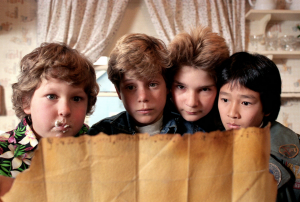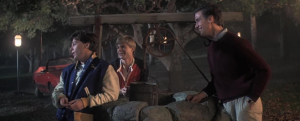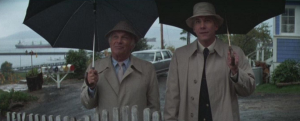16 The Goonies (1985)
The Goonies Rich Vs. Poor
By Chris Nelson
The Goonies is full of adventure, pirates, and scary criminals that are out to get a group of kids, but that’s not all this film is full of. If you take a good look at what is happening in this film you will see the diverse positions of difference, power, and discrimination (DPD) in this film. The main position in this film is socio-economic discrimination and that is what this paper is mainly going to touch on. But within the film there are many other positions of DPD as Robert, author of “Things You Have to Ignore in Order to Enjoy Watching The Goonies”, points out there is “Fat shaming and bullying. Racial stereotyping. Drug and sex abuse references. Assault, theft, and attempted murder. And that’s just in the first 30 minutes” (Mason). I will be discussing how the rich take advantage and overpower the weaker or lower-income characters throughout this film. As we go through, you will see the many different DPD points in the film The Goonies.
The Goonies was written by Steven Spielberg and directed by Richard Donner released in 1985. The story of this film is about a group of kids that adventure out to save their small community from foreclosure in the Goon Dock neighborhood of Astoria, Oregon. After finding an old treasure map in the attic of Mikey and Brand Walsh, they set off in search of the long-lost pirate treasure of One-Eyed Willy, a legendary 17th-century pirate. The treasure is protected by a trail of booby traps that the group of kids has to overcome or succumb to the fate of the pirate’s traps. While on their adventure they also have to evade a family of criminals (the Fratelli’s) that are on the run from law enforcement and after the treasure for themselves.

In the mid-1980s filmmakers made it popular to have kids face challenges that their parents couldn’t fix. This film was produced towards the end of the New Hollywood era, where new filmmakers were making a name for themselves. A popular aspect for these new filmmakers was to use medium close-ups to close-ups of the actors to draw in the suspense. This film like others produced in this era shows the difficulties that money and lack of money carry within themselves. It shows that being part of a social class defined who and what one is. Someone with higher social class and economics could get away with buying up a bunch of homes and bulldozing them to the ground to build a golf course for the local country club that only the wealthy can attend. The lower class has to work and fight twice as hard to overcome any obstacles that get in their way.
Socioeconomic discrimination can be found among the two different groups. In the beginning, Mouth is seen airing out the tires on Brand’s bike and Mikey, Brand’s younger brother, says that he worked all summer for that bike. From the looks of it, Brand is probably in high school while Mickey and his friends are in middle school. A little later, we see Troy who is of a wealthier class and is the son of Mr. Perkins, the country club developer that is taking the Goonies homes. Troy is the same age as Brand but is driving in a new bright red convertible car. Another position of showing the differences is described by David author of “The Goonies and Marxist Genres”, he tells us “The Goonies class is also shown as lower than the country club members are when Troy has the ability to pull The Goonies, specifically the most beautiful girl, up through the well. Their being in the tunnels underneath the country club shows The Goonies lower class and Troy is trying to bring the lower-class girl up to his social status through marriage, which would also elevate the rest of The Goonies through association” (Wooten).

Mr. Perkins shows us his wealth by being able to turn the goonies’ homes into a golf course for the country club. This also shows us that not only does he have power but that his son Troy carries power from his father’s upper-class status by the car he drives and the way he treats people. Troy isn’t a main character in this film but he shows the male masculinity and makes his heterosexuality known by trying to look up Andy’s skirt in the car and telling his friends that he hasn’t “made it with her yet and I stress yet”.
Another form of power in this film is the way Mikey and the rest of the goonies fight to save their homes. The adventure that the goonies embark on shows that they have the power to not give up and they aren’t going to accept the fate that is being handed to them. Mikey has the power to push the rest of the goonies to keep on going and believes the treasure is at the end even when they want to give up and go home. David illustrates this by telling us that “The difference in social location between The Goonies and the country club is evident in the country club owners foreclosing on The Goonies homes. The country club owners obviously have power and wealth, which is indicative of the bourgeoisie” (Wooten).

Halfway through the film a new character is introduced named Sloth who is physically deformed and mentally disabled. Sloth is another son of Mama Fratelli, the criminals that are chasing the goonies. We find out that Sloth is the way he is because his Mama dropped him on his head at least twice, possibly more when he was a baby. He is discriminated against in his own family because of the way he looks and acts. Because he is deformed and considered a monster to his family, they keep him chained up in the basement. The producer uses the sounds of Sloth yelling and the rattling of chains to give the audience a sense of horror and a glimpse of what could be in the basement. It’s not until one of the goonies (Chunk) is captured and placed in the basement with Sloth that we finally see what is being locked up down there. It’s at that point when Chunk befriends Sloth and they are able to break free and join the rest of the goonies on their adventure. As the staff of Grunge tells us about the first time Sloth is introduced to the film:
When we’re first introduced to Sloth — the giant, physically deformed brother of Jake and Francis — Jake is singing opera to him and yelling at him for interrupting. Sloth is chained in a room in the basement of the restaurant, with only a small TV for entertainment. Sloth is making big scary noises, and Mikey, in hiding, looks freaked out. He takes pity on the “thing in the room” (since we don’t know yet what Sloth’s face looks like) and pushes his food closer to him. Sloth turns around, revealing his terrifying visage, and Mikey turns tail and runs. Sloth is, for all rights and purposes, introduced as a monster (“The Dark Truth”).
Throughout this essay, we have seen how the rich take advantage and overpower the weaker or lower-income characters in this film. And have discussed a few of the many different DPD points in the film The Goonies. Many of the films of this era and even films produced today have an association with socioeconomic discrimination or just discrimination. Viewers are always seeing how the lower class is manipulated by the higher class. While the lower class finds a way to fight back and be triumphant in the end. This film shows us many different types of DPD situations but the one that stood out the most is the differences between social class and how they are treated in this time period, but most importantly how it hasn’t changed much to current times. The Goonies was released in 1985 and is still quite a popular film from its era. Hollywood was at the end of the new Hollywood era and things had started to calm down. The new generation of young filmmakers had made names for themselves and continued to release popular films. This era of filmmaking likes to take kids or teens and make them the heroes of the film and that’s what the Goonies have done here. Showing us that despite what the adults can do, the kids of this film are going to fight to save what they hold dearest to them.
REFERENCES
Mason, Robert F. “Things You Have to Ignore in Order to Enjoy Watching ‘The Goonies’.” Ranker.com, Ranker, 23 Oct. 2018, www.ranker.com/list/dumb-things-you-ignore-goonies/robert-f-mason.
“The Dark Truth Behind The Goonies.” Grunge.com, Grunge, 25 June 2018, www.grunge.com/37312/dark-truth-behind-goonies/.
Wooten, David. The Goonies and Marxist Genres – Wooten Film Machine, sites.google.com/site/wootenfilmmachine/some-of-my-works/major-papers/the-goonies.

